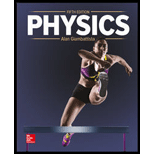
(a)
The particle with greater tunnelling probability.
(a)
Answer to Problem 48P
The particle with greater tunnelling probability is
Explanation of Solution
Write the expression for tunnelling probability.
Here,
Write the expression for
Here,
Since the mass of deuteron is greater than that of the proton, the proton has greater tunnelling probability.
(b)
The ratio of the tunnelling probabilities.
(b)
Answer to Problem 48P
The ratio of the tunnelling probabilities is
Explanation of Solution
Write the expression for tunnelling probability of proton and deuteron.
Here,
Write the expression for
Here,
Here,
Subtracting (IV) form (V)
The mass of the deuteron is two times the mass of the proton i.e.
Rearranging (I)
Substituting (VI) in (VII) and using
Conclusion
Substitute
Thus, the ratio of tunnelling probability is
Want to see more full solutions like this?
Chapter 28 Solutions
Physics
 College PhysicsPhysicsISBN:9781305952300Author:Raymond A. Serway, Chris VuillePublisher:Cengage Learning
College PhysicsPhysicsISBN:9781305952300Author:Raymond A. Serway, Chris VuillePublisher:Cengage Learning University Physics (14th Edition)PhysicsISBN:9780133969290Author:Hugh D. Young, Roger A. FreedmanPublisher:PEARSON
University Physics (14th Edition)PhysicsISBN:9780133969290Author:Hugh D. Young, Roger A. FreedmanPublisher:PEARSON Introduction To Quantum MechanicsPhysicsISBN:9781107189638Author:Griffiths, David J., Schroeter, Darrell F.Publisher:Cambridge University Press
Introduction To Quantum MechanicsPhysicsISBN:9781107189638Author:Griffiths, David J., Schroeter, Darrell F.Publisher:Cambridge University Press Physics for Scientists and EngineersPhysicsISBN:9781337553278Author:Raymond A. Serway, John W. JewettPublisher:Cengage Learning
Physics for Scientists and EngineersPhysicsISBN:9781337553278Author:Raymond A. Serway, John W. JewettPublisher:Cengage Learning Lecture- Tutorials for Introductory AstronomyPhysicsISBN:9780321820464Author:Edward E. Prather, Tim P. Slater, Jeff P. Adams, Gina BrissendenPublisher:Addison-Wesley
Lecture- Tutorials for Introductory AstronomyPhysicsISBN:9780321820464Author:Edward E. Prather, Tim P. Slater, Jeff P. Adams, Gina BrissendenPublisher:Addison-Wesley College Physics: A Strategic Approach (4th Editio...PhysicsISBN:9780134609034Author:Randall D. Knight (Professor Emeritus), Brian Jones, Stuart FieldPublisher:PEARSON
College Physics: A Strategic Approach (4th Editio...PhysicsISBN:9780134609034Author:Randall D. Knight (Professor Emeritus), Brian Jones, Stuart FieldPublisher:PEARSON





